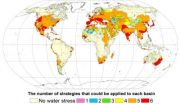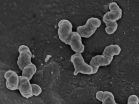(Press-News.org) Dartmouth researchers explored the type and number of connections in transcription factor networks (TFNs) to evaluate the role assortativity plays on robustness in a study published in PLOS Computational Biology in August. The study found that the assortativity signature contributes to a network's resilience against mutations.
"In simulations, it seems that varying the out-out assortativity of TFN models has a greater effect on robustness than varying any of the other three types of assortativity," said Dov A. Pechenick, PhD, lead author and former researcher at the Computational Genetics Laboratory at Dartmouth College, Hanover, NH. "We determined this by varying all four types of assortativity in the signature and then measuring robustness."
Transcription factors (TFs) are proteins that initiate and regulate the expression of a gene. To achieve their genetic mission, TFs also regulate one another's expression. Individual TFs connect to each other through connections that point in or out, forming a network. The direction of the coupling indicates regulatory control; an outbound connection by one TF stipulates its control over another, whereby it turns that TF on or off with respect to gene expression.
Many such connected pairings occur in a network, and their types determine a network's assortativity, which measures whether these pairings tend to occur between TFs that have similar numbers of connections. For example, when TFs in a pairing are likely to possess similar numbers of outgoing connections, out-out assortativity is high. If they are likely to possess very different numbers of incoming connections, in-in assortativity is low. Taken together, measures for the different kinds of assortativity create a signature. According to Pechenick, "There are four types of assortativity in directed networks, and the assortativity signature is a way of looking at all four at once."
Pechenick and his Dartmouth co-authors evaluated the assortativity signatures in published TFNs of 41 distinct human cell and tissue types and found that an above average number of connected TFs had similar numbers of outgoing connections (high out-out assortativity). Furthermore, this property, more so than the other three types of assortativity, seemed to be a predictor of robustness.
"Robustness is a measure of how resilient an overall pattern of TF gene expression is over time when confronted with mutations in the regulatory instructions of these TFs. If mutations tend to change the pattern, then robustness is low. If mutations tend to have no effect on the pattern, then robustness is high," said Pechenick.
This Dartmouth study was the first to look at the assortativity signatures of TFNs and their impact on robustness. "Results suggest that measuring the assortativity signature of a TFN can tell you something about its robustness," said Pechenick. "For researchers that wish to understand and simulate biological networks, these results indicate the importance of considering assortativity."
INFORMATION:
Co-authors of the study included Joshua L. Payne and Jason H. Moore. The study was supported by NIH Grant #s LM009012, LM 010098, AI59694, GM103506, and GM103534.
The Computational Genetics Laboratory at Dartmouth is part of the Institute for Quantitative Biomedical Sciences at The Geisel School of Medicine and Dartmouth College in Hanover, NH, USA. It is affiliated with the Department of Genetics, the Section of Biostatistics and Epidemiology in the Department of Community and Family Medicine and the Bioinformatics Shared Resource at Norris Cotton Cancer Center.
Norris Cotton Cancer Center combines advanced cancer research at Dartmouth and the Geisel School of Medicine with patient-centered cancer care provided at Dartmouth-Hitchcock Medical Center, at Dartmouth-Hitchcock regional locations in Manchester, Nashua, and Keene, NH, and St. Johnsbury, VT, and at 12 partner hospitals throughout New Hampshire and Vermont. It is one of 41 centers nationwide to earn the National Cancer Institute's "Comprehensive Cancer Center" designation. Learn more about Norris Cotton Cancer Center research, programs, and clinical trials online at cancer.dartmouth.edu.
Assortativity signatures of transcription factor networks contribute to robustness
2014-08-29
ELSE PRESS RELEASES FROM THIS DATE:
Revealing a novel mode of action for an osteoporosis drug
2014-08-29
Raloxifene is a U.S. Food and Drug Administration (FDA)-approved treatment for decreasing fracture risk in osteoporosis. While raloxifene is as effective at reducing fracture risk as other current treatments, this works only partially by suppressing bone loss. With the use of wide- and small-angle x-ray scattering (WAXS and SAXS, respectively), researchers carried out experiments at the U.S. Department of Energy's (DOE's) Advanced Photon Source (APS) at Argonne National Laboratory that revealed an additional mechanism underlying raloxifene action, providing an explanation ...
Study reveals how Ebola blocks immune system
2014-08-29
Researchers at the Washington University School of Medicine have identified one way the Ebola virus dodges the body's antiviral defenses, providing important insight that could lead to new therapies, in research results published in the journal Cell Host & Microbe.
In work performed at Beamline 19ID at Argonne National Laboratory's Advanced Photon Source, the researchers developed a detailed map of how a non-pathogenic Ebola protein, VP24, binds to a host protein that takes signaling molecules in and out of the cell nucleus.
Their map revealed that the viral protein ...
Argonne scientists pioneer strategy for creating new materials
2014-08-29
Making something new is never easy. Scientists constantly theorize about new materials, but when the material is manufactured it doesn't always work as expected. To create a new strategy for designing materials, scientists at the Department of Energy's Argonne National Laboratory combined two different approaches at two different facilities to synthesize new materials.
This new strategy gives faster feedback on what growth schemes are best, thus shortening the timeframe to manufacture a new, stable material for energy transport and conversion applications.
A recent ...
Aging Africa
2014-08-29
Boulder, Colorado, USA – In the September issue of GSA Today, Paul Bierman of the University of Vermont–Burlington and colleagues present a cosmogenic view of erosion, relief generation, and the age of faulting in southernmost Africa. By measuring beryllium-10 (10Be) in river sediment samples, they show that south-central South Africa is eroding at the slow rate of about five meters per million years, consistent with rates in other non-tectonically active regions.
By measuring 10Be and aluminum-26 (26Al) in exposed quartzites, Bierman and colleagues find that undeformed ...
Preventing cancer from forming 'tentacles' stops dangerous spread
2014-08-29
EDMONTON, AB – A new study from the research group of Dr. John Lewis at the University of Alberta (Edmonton, AB) and the Lawson Health Research Institute (London, ON) has confirmed that "invadopodia" play a key role in the spread of cancer. The study, published in Cell Reports, shows preventing these tentacle-like structures from forming can stop the spread of cancer entirely.
Roughly 2 in 5 Canadians will develop cancer in their lifetime, and one in four of them will die of the disease. In 2014, it's estimated that nine Canadians will die of cancer every hour. Thanks ...
Reducing water scarcity possible by 2050
2014-08-29
Water scarcity is not a problem just for the developing world. In California, legislators are currently proposing a $7.5 billion emergency water plan to their voters; and U.S. federal officials last year warned residents of Arizona and Nevada that they could face cuts in Colorado River water deliveries in 2016.
Irrigation techniques, industrial and residential habits combined with climate change lie at the root of the problem. But despite what appears to be an insurmountable problem, according to researchers from McGill and Utrecht University it is possible to turn the ...
Evidence mounting that older adults who volunteer are happier, healthier
2014-08-29
Toronto, Canada – Older adults who stay active by volunteering are getting more out of it than just an altruistic feeling – they are receiving a health boost!
A new study, led by the Rotman Research Institute at Baycrest Health Sciences and published online this week in Psychological Bulletin, is the first to take a broad-brush look at all the available peer-reviewed evidence regarding the psychosocial health benefits of formal volunteering for older adults.
Lead investigator Dr. Nicole Anderson, together with scientists from Canadian and American academic centres, ...
NASA sees Hurricane Cristobal racing through North Atlantic
2014-08-29
Satellite imagery shows Hurricane Cristobal racing through the North Atlantic on Friday, August 29 while losing its tropical characteristics. An image from NOAA's GOES-East satellite showed Cristobal headed south of Greenland. The previous day, NASA's TRMM satellite saw heavy rainfall occurring in the hurricane.
In a visible image from NOAA's GOES-East satellite on August 29 at 7:45 a.m. EDT, Hurricane Cristobal was moving through the North Atlantic about 500 miles southwest of Greenland. The image was created by the NASA/NOAA GOES Project at NASA's Goddard Space Flight ...
CCNY team defines new biodiversity metric
2014-08-29
To understand how the repeated climatic shifts over the last 120,000 years may have influenced today's patterns of genetic diversity, a team of researchers led by City College of New York biologist Dr. Ana Carnaval developed a new biodiversity metric called "phylogeographic endemism."
It quantifies the degree to which the genetic variation within species is restricted in geographical space.
Dr. Carnaval, an assistant professor of biology, and 14 other researchers from institutions in Brazil, Australia and the United States, analyzed the effects of current and past climatic ...
Hydrogen powers important nitrogen-transforming bacteria
2014-08-29
This news release is available in German. Nitrite-oxidizing bacteria are key players in the natural nitrogen cycle on Earth and in biological wastewater treatment plants. For decades, these specialist bacteria were thought to depend on nitrite as their source of energy. An international team of scientists led by Holger Daims, a microbiologist at the University of Vienna, has now shown that nitrite-oxidizing bacteria can use hydrogen as an alternative source of energy. The oxidation of hydrogen with oxygen enables their growth independent of nitrite and a lifestyle outside ...



